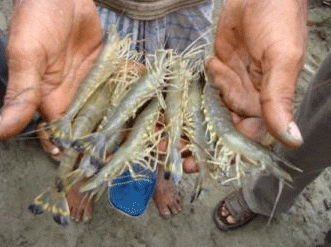The research is part of the project Investigating the vulnerability of and economics of adapting aquaculture in Vietnam to climate change, partly funded by the CGIAR Research Program on Climate Change, Agriculture and Food Security (CCAFS).
Fish on the Fryer
Aquaculture in the Mekong River Delta accounts for 80% of Vietnams total shrimp production and 76% of its cultured fish production (2008 statistics). In addition to our beleaguered catfish, the most important product here is brackish-water shrimp, cultivated both extensively and intensively over large areas of the delta. Being largely coastal endeavors, catfish and shrimp farming will undoubtedly be affected by the changing climate.
Rising temperatures are one problem. On the plus side, high temperatures increase the metabolic rate of the fish and thus decrease the amount of time they take to reach marketable size. The downside is that they also increase the amount of food, and thus the cash input, needed to sustain the fish. Increased evapo-transpiration and sea level rise means higher salt content in shallow shrimp ponds. With the threat of increased flooding and salt water intrusion, farmers will have to raise pond dikes. Wetter wet seasons, drier dry seasons, and the increased frequency of extreme events like Typhoon Linda in 1997 only add to the list of worries.
Talk is Cheap, but Adaptation Measures Arent.
Sooner or later and preferably sooner farmers are going to have to adapt to these changes. Most of them will do it autonomously, or as an inevitable reaction to current circumstances. These autonomous measures will happen regardless of organized adaptation efforts from outside organizations or governments, but they still bear quite a cost to the farmers.
Interestingly, most adaptation cost/benefit analyses dont take into account the cost of autonomous adaptation, something which the analysis from WorldFishs researchers aims to correct. To do so, they first defined the baseline farm-level costs and incomes for shrimp and catfish systems and then determined how those inputs might change based on interviews with expert stakeholders. They then applied the cost-benefit analysis at both the farm and industry level. They also accounted for benefits to farmers due to planned (rather than autonomous) adaptation measures undertaken by the government.
The Shrimps are Alright
The analyses reveal that catfish operations, already in a precarious economic position, may not be viable for much longer under the influence of climate change. Unless major changes are made to ensure the sustainability of the system the breeding of salt-tolerant varieties, improved food conversion rates through feed formulation research, renewed emphasis on cooperative production groups, and reduction of overall capital outlay catfish farming operations could become unprofitable within as little as five years.
Shrimp farming, on the other hand, requires less capital outlay and is much friendlier to the environment. Extensive shrimp production at present the dominant system is thus expected to be more resilient to the impacts of climate change, with positive net incomes well into 2020.

The Obvious Question:
Why hasnt anybody done this analysis before? Isnt it critical to know for whom adaptation will simply be too costly to bear?
Calculating adaptation costs and benefits especially for aquaculture is much more complicated than it seems, and there are still doubts as to the feasibility of the analysis. For example, computer models projecting fish performance under the influence of climate change simply dont exist yet. In lieu of such models, what are the implications of using expert opinion to project performance changes instead? Furthermore, how can we account for fluctuations in the future market or technological advances that might influence the outcome of adaptation measures? Such questions complicate but dont invalidate the calculation of costs and benefits for adaptation in aquaculture. They also give us solid indications as to the direction future research should take, with the aim of better estimating whether we can truly afford to adapt to climate change.
January 2013



